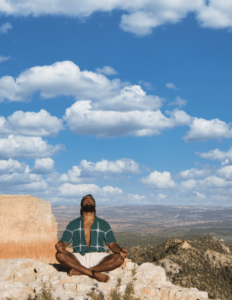Shray Goel is an independent mental health researcher. Meditation is an ancient practice that uses mindfulness and concentration to bring yourself into the present moment. It has been used for centuries to reduce stress, improve health, and achieve inner peace.
Rethinking Meditation: The Marketing Disaster and a Way Forward

Why Meditation is a Marketing Disaster
Meditation. It’s possibly the worst-marketed thing on the planet. If it were a company, I’d march right up to the CEO of Meditation, Inc., and say, “Fire your marketing guy!” You see, despite being an avid meditator for nearly a decade and reaping countless benefits, I still struggle to stick with it and convince myself of its essential nature. That’s not a product problem – that’s a branding problem.
Meditation: The Basics from an Everyday Guy’s Perspective
As we dive into this beginner’s guide, I’ll first lay out what meditation is, using everyday analogies to keep you motivated for your daily sessions. I’ll also detail some easy, user-friendly meditation techniques that beginners (and even experienced meditators) can adopt. You can do what you want with this advice; it’s not prescriptive but is aimed to be as actionable as possible.
Meditation: The Misconceptions and the Reality
Many misconceptions surround meditation, like needing training or being in a certain mood. Let me put those myths to bed right now – meditation is easy, fun, and can be done anytime, any place. You can meditate anytime your schedule permits, no matter where you are.
Don’t obsess over the “rules”: People often insist that you must meditate daily for a specific number of minutes to make it count. But the truth is, consistency is more critical than duration. One minute one day, an hour the next – it’s the habit that matters, not the clock.
Embracing Meditation with Flexibility
The key is not to treat meditation, or anything in your life, with a rigid, fixated mindset. Instead, treat yourself with grace. Understand that meditation is an investment back into yourself. It helps both the present and the future version of yourself to flourish.
Meditation: The Regular Maintenance Your Brain Needs
Just like brushing your teeth, showering, or hitting the gym, meditation should be a daily routine. We don’t question these personal hygiene habits; we’ve accepted them as necessary for our well-being. Consider meditation as the same – a routine maintenance for your brain. You wouldn’t skip an oil change on your car, right? Similarly, consistent meditation allows your brain, your most vital vehicle, to run smoother for longer.
Meditation isn’t about reaching a state of nirvana or achieving complex yoga poses. It’s about turning your focus inward – practicing ‘interoception.’ The goal is to conduct an internal body scan, to understand the internals of your body, and how they are functioning. This could be noticing how your brain feels, tuning into your muscle tension, or even counting your heartbeats. By closing your eyes and paying attention to your body, you can practice the purest form of self-love. After all, your attention is your most valuable asset. Meditation is the process of reclaiming it from external distractions and refocusing it on yourself.

Shray Goel Meditating In Utah
Settle in as we debunk another meditation myth: the notion that it requires a particular mood or environment. You could be halfway through a Sunday roast, or queuing up in the bank, and it would still be the perfect time to meditate. So, while many experts advise daily meditation, the key is flexibility. You’re the CEO of your own mind, and the boardroom is open 24/7, no tie required. You don’t have to punch in at a certain time each day, or log a specific number of minutes. Instead, just like any good workout, consistency is the key.
But, and here’s where it gets interesting, there’s a difference between consistency and rigidity. The idea isn’t to log your meditation time like a dictator keeping tally of his gold reserves. It’s not a box to tick off, but rather a way to invest in your future self. Meditation isn’t a duty, it’s an act of self-love, a grace we gift ourselves. It’s about more than just avoiding burnout; it’s about stoking a fire within yourself that fuels your future triumphs.
We all agree on brushing our teeth daily, right? And showering is universally accepted as a good idea. And while we’re at it, changing the oil in our car every few thousand miles is a given. So, why is the idea of daily meditation still a hard sell for some of us? We don’t wait for our teeth to rot before we brush them, we don’t wait for the car engine to seize up before changing the oil, so why should we wait for mental chaos to meditate? It’s routine maintenance, like flossing the gears of your mental machinery to keep them running smoothly.
Like most things in life, meditation doesn’t have to be complicated. Contrary to popular belief, you don’t need to twist yourself into a pretzel or levitate off the floor to reap its benefits. It’s not about achieving a nirvana-like state of enlightenment, but rather, it’s about turning your attention inward, shining the spotlight on the inner workings of your mind and body. It’s about focusing on a concept that’s simple yet profound: interoception.
Meditation invites you to conduct an internal body scan, like a mini-MRI, for as long as you feel comfortable. It’s a chance to check in with yourself. How’s your brain feeling? What about your muscles? Stomach? It’s about tuning into your heartbeats, feeling the depth of your breath. And this can be done anywhere, anytime. The main challenge is tuning out the cacophony of the attention economy: the relentless pings from social media, the incessant news alerts, the clamoring of the markets.
Meditation is an act of reclaiming your attention, the most valuable asset you possess. It’s the purest form of self-love, a respite from the relentless external demands and an opportunity to check in with yourself. And, perhaps most importantly, there’s no need to judge yourself or feel guilty if you struggle initially. That’s perfectly normal, and part of the process. You see, meditation is a bit like learning to ride a bike – it might take a few falls before you get the balance right.

So now let’s dive into the practical aspects. Many people shy away from meditation, thinking it’s too complex or their minds are too hyperactive. But, let me assure you, there’s no such thing as a ‘bad meditator’. Meditation is as unique as your fingerprint, and there are several techniques to explore. The only universal rule is to focus on your breath. You see, our breath is the bridge between our mind and body, the silent soundtrack to our inner universe.
For beginners, I often recommend a simple technique that I like to call “counting breaths.” It’s as easy as it sounds – you just count the number of breaths you take. If you lose count, no problem! Just start again. You’ll be surprised how this simple act can help declutter your mind. Another effective technique is box breathing – a four-part cycle involving inhaling, holding the breath, exhaling, and holding again. This method can make your body feel extraordinarily light and allows you to focus all your energy on your breath.
One technique that has personally helped me is diaphragmatic breathing, or breathing deeply into your belly. Most of us take shallow breaths, barely utilizing our lungs’ full capacity. But by placing your hands on your stomach and ensuring your breath pushes your belly outwards, you can unlock the full potential of your lungs and enhance your meditation. Another handy trick is focusing on nasal breathing – taking deep inhales through your nose and powerful exhales through your mouth.
As you grow more comfortable with meditation, you may find it adds a new dimension to your travel experiences. Imagine meditating on a sun-kissed beach, or atop a mountain, or in a bustling city park. These experiences can lend an extra depth to your meditation, a sensory backdrop that makes it all the more memorable.
As your meditation practice evolves, you might want to explore more advanced techniques. One such method is visualization. Visualization is a powerful tool that has been used by successful people across various fields – from athletes visualizing their victory to business leaders envisioning their goals. The same principle can be applied to meditation. You can visualize a serene place, like a tranquil forest or a peaceful beach. Or, you might choose to visualize positive experiences and outcomes. Over time, this practice can help manifest these positive visions into reality.
Another advanced technique is mantra meditation. In this technique, you silently repeat a word or phrase to help focus your mind. The mantra could be anything that resonates with you. It could be a word like ‘peace’ or ‘love’, or a phrase like ‘I am calm’ or ‘I am grateful’. The repetition of the mantra helps to clear the mind of distractions and deepen your meditation practice.
If you’re seeking to deepen your practice even further, consider introducing mindfulness into your everyday activities. Mindfulness is simply the practice of paying attention to the present moment, without judgement. You can practice mindfulness while doing almost anything – while eating, walking, working, or even while doing household chores. By fully engaging with the present moment, you’re extending the benefits of meditation into your everyday life.
Additionally, you might find it beneficial to join a meditation community or group. Meditating with others can enhance the experience and provide a sense of camaraderie. It can also provide a space for sharing experiences and discussing challenges, which can be very helpful in deepening your understanding and practice. These groups can be found both in-person in local communities and online.

Shray Goel Meditating in Zion National Park
To keep your practice interesting, you might want to explore different types of meditation. Beyond mindfulness and mantra meditation, there are numerous other forms to try. Transcendental Meditation, Loving-Kindness Meditation, and Zen Meditation are just a few examples. Each of these methods has unique characteristics and can offer different benefits, so don’t hesitate to experiment and find what resonates most with you.
Don’t forget to celebrate your progress along the way. Remember that every step, no matter how small, is progress in your meditation journey. Some days, you might find it easy to meditate, and other days, it might be challenging. That’s okay. The important thing is to be patient with yourself and keep showing up for your practice.
Lastly, consider keeping a meditation journal. Write down your experiences, observations, challenges, and breakthroughs. This can serve as a valuable tool to track your progress, notice patterns, and gain insights into your inner workings. It also provides a space for reflection, which can further deepen your meditation practice.
Remember, meditation is a journey, not a destination. There is no ‘end goal’ to reach, but rather a continual process of growth, learning, and self-discovery. The key is to approach it with patience, curiosity, and kindness towards yourself. And remember, it’s not about achieving a perfect state of bliss or tranquility, but about building a deeper connection with yourself, one breath at a time. Happy meditating!
About Shray Goel
Shray Goel is an accomplished entrepreneur, technology founder, and commercial real estate developer. Shray Goel graduated from the University of California, Santa Barbara, with a major in Economics and a minor in Global Studies and Technology Entrepreneurship.
Professionally, Shray’s career has spanned over a decade in technology project and product management.
Shray was responsible for managing the development of web applications at multiple public corporations before founding his real estate development business. He is a certified Agile Scrum Master and Project Management Professional.
Since 2010, Shray Goel has owned and managed more than $10 million in multifamily real estate assets throughout the United States.
One of Shray’s many businesses provides flexible housing solutions to traveling medical professionals, including doctors and nurses. He has served clients at prestigious California medical facilities such as Rady Children’s Hospital, University of California San Diego Medical Center, and Scripps Mercy Hospital.
Shray Goel mentors busy professionals in achieving breakthroughs in life by leveraging mental health improvements, positive habits, and productivity hacks. Shray has a proven track record of advising clients on how to get the most out of their lives and investments. He enjoys writing about mental health, financial technology, and investing strategies.
For more information on Shray Goel, visit his website at ShrayGoel.com and follow him on social media:
